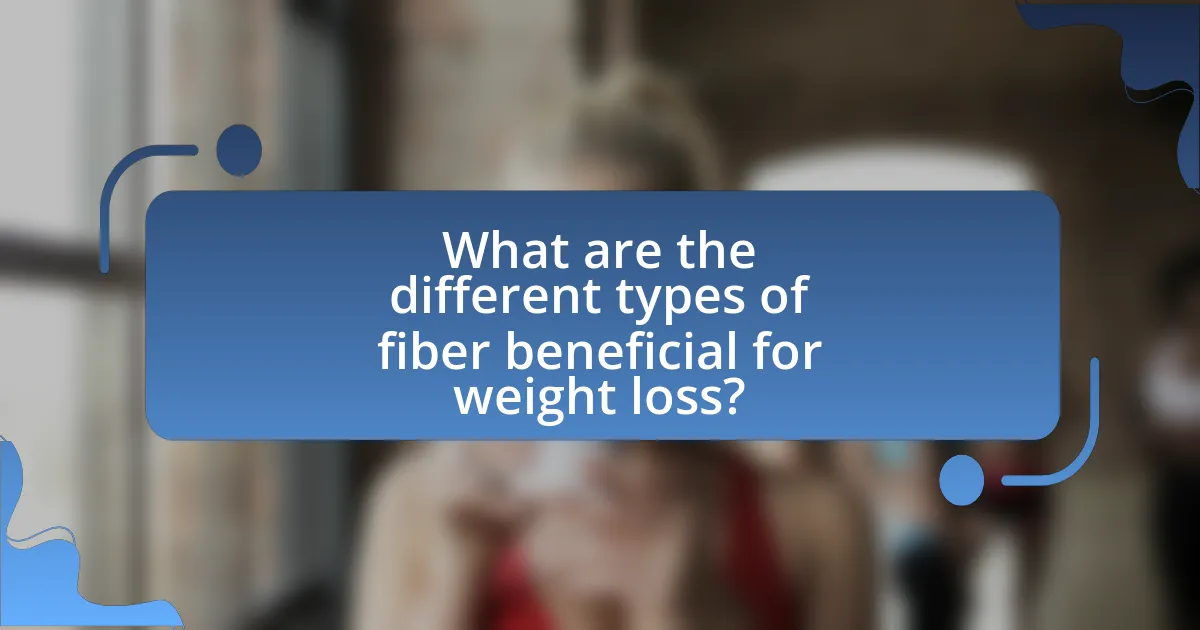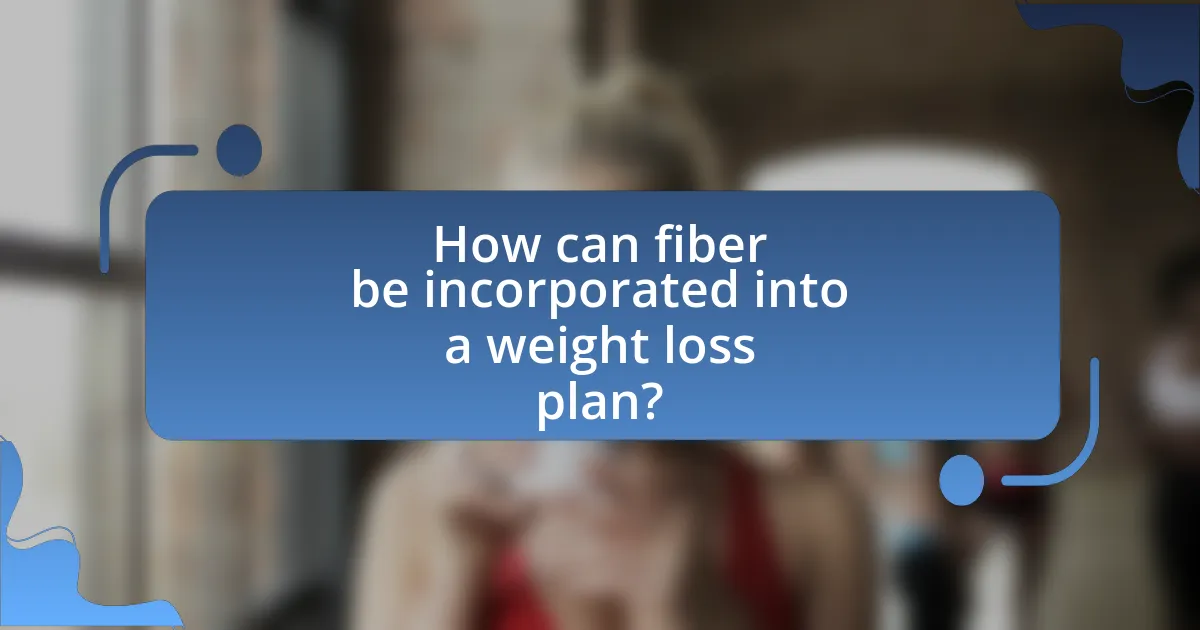The article focuses on the significant role of fiber in a weight loss strategy, highlighting its ability to promote satiety, reduce calorie intake, and stabilize blood sugar levels. It discusses the effectiveness of soluble and insoluble fibers, emphasizing their contributions to appetite regulation and digestive health. Additionally, the article outlines various high-fiber foods, practical tips for increasing fiber intake, and the importance of incorporating fiber into meal planning to enhance weight management efforts. Overall, it presents evidence-based insights into how fiber can support weight loss and overall health.

What is the role of fiber in a weight loss strategy?
Fiber plays a crucial role in a weight loss strategy by promoting satiety, which helps reduce overall calorie intake. When consumed, fiber expands in the stomach, leading to a feeling of fullness that can prevent overeating. Studies indicate that diets high in fiber can lead to greater weight loss; for instance, a review published in the journal “Obesity” found that individuals who increased their fiber intake lost more weight compared to those who did not. Additionally, fiber slows down digestion and stabilizes blood sugar levels, which can further aid in weight management by reducing cravings and preventing spikes in hunger.
How does fiber contribute to weight loss?
Fiber contributes to weight loss by promoting satiety and reducing overall calorie intake. High-fiber foods take longer to chew and digest, which helps individuals feel full for a longer period, thereby decreasing the likelihood of overeating. Research indicates that diets rich in fiber can lead to a reduction in body weight; for instance, a study published in the American Journal of Clinical Nutrition found that increasing fiber intake by 14 grams per day can result in a 10% decrease in calorie intake and a weight loss of about 4.2 pounds over four months. Additionally, fiber slows the absorption of sugar, helping to stabilize blood sugar levels and reduce cravings.
What types of fiber are most effective for weight loss?
Soluble fiber is most effective for weight loss. This type of fiber dissolves in water to form a gel-like substance, which slows digestion and promotes a feeling of fullness. Studies have shown that soluble fiber can help reduce appetite and calorie intake, contributing to weight loss. For instance, a study published in the journal “Obesity” found that participants who increased their soluble fiber intake lost more weight compared to those who did not. Additionally, foods high in soluble fiber, such as oats, beans, and fruits, have been linked to improved metabolic health, further supporting weight management efforts.
How does fiber affect satiety and hunger levels?
Fiber increases satiety and reduces hunger levels by promoting feelings of fullness and slowing digestion. When consumed, fiber absorbs water and expands in the stomach, which leads to a prolonged sensation of fullness. Studies have shown that high-fiber diets can lead to lower calorie intake, as individuals feel satisfied with fewer calories. For instance, a study published in the American Journal of Clinical Nutrition found that participants who consumed a high-fiber diet reported greater satiety and reduced hunger compared to those on a low-fiber diet. This effect is attributed to fiber’s ability to regulate hormones related to hunger, such as ghrelin, and to enhance the release of satiety hormones like peptide YY.
Why is fiber important for overall health during weight loss?
Fiber is important for overall health during weight loss because it promotes satiety, aids digestion, and helps regulate blood sugar levels. High-fiber foods, such as fruits, vegetables, and whole grains, increase feelings of fullness, which can lead to reduced calorie intake. Additionally, fiber supports digestive health by preventing constipation and promoting regular bowel movements. Research indicates that diets high in fiber can lower the risk of chronic diseases, such as heart disease and type 2 diabetes, which are particularly relevant during weight loss efforts. For instance, a study published in the Journal of Nutrition found that individuals who consumed more fiber had a lower risk of obesity and related health issues.
What are the digestive benefits of fiber?
Fiber promotes digestive health by enhancing bowel regularity and preventing constipation. It adds bulk to the stool, which facilitates its passage through the intestines. According to a study published in the American Journal of Clinical Nutrition, increased fiber intake is associated with a lower risk of developing gastrointestinal disorders, such as diverticulitis and hemorrhoids. Additionally, soluble fiber can help regulate gut bacteria, contributing to a balanced microbiome, which is essential for optimal digestion and nutrient absorption.
How does fiber impact blood sugar levels?
Fiber helps regulate blood sugar levels by slowing down the digestion and absorption of carbohydrates. This slower process prevents rapid spikes in blood glucose, leading to more stable blood sugar levels. Studies indicate that diets high in fiber, particularly soluble fiber, can improve glycemic control and reduce the risk of type 2 diabetes. For instance, a meta-analysis published in the journal “Diabetes Care” found that increasing fiber intake is associated with lower fasting blood glucose levels and improved insulin sensitivity.

What are the different types of fiber beneficial for weight loss?
The different types of fiber beneficial for weight loss are soluble fiber and insoluble fiber. Soluble fiber, found in foods like oats, beans, and fruits, helps to slow digestion and increase feelings of fullness, which can reduce overall calorie intake. Insoluble fiber, present in whole grains, nuts, and vegetables, adds bulk to the stool and promotes regular bowel movements, aiding in digestive health and potentially supporting weight management. Research indicates that diets high in fiber can lead to lower body weight and reduced risk of obesity, as evidenced by a study published in the Journal of Nutrition, which found that increased fiber intake is associated with lower body weight and fat mass.
What are soluble and insoluble fibers?
Soluble fibers are types of dietary fibers that dissolve in water, forming a gel-like substance in the digestive tract, which can help lower blood cholesterol and glucose levels. Common sources of soluble fiber include oats, beans, lentils, fruits, and vegetables. Insoluble fibers, on the other hand, do not dissolve in water and add bulk to the stool, aiding in digestion and preventing constipation. Sources of insoluble fiber include whole grains, nuts, and the skins of fruits and vegetables. Both types of fiber play crucial roles in digestive health and can contribute to weight loss by promoting satiety and reducing overall calorie intake.
How does soluble fiber aid in weight management?
Soluble fiber aids in weight management by promoting feelings of fullness and reducing overall calorie intake. When soluble fiber is consumed, it forms a gel-like substance in the digestive tract, which slows down digestion and prolongs satiety. Research indicates that diets high in soluble fiber can lead to a reduction in body weight and fat mass; for instance, a study published in the American Journal of Clinical Nutrition found that increasing soluble fiber intake by 14 grams per day was associated with a 10% decrease in calorie intake and a 4% reduction in body weight over four months. This mechanism helps individuals manage their weight more effectively by curbing hunger and preventing overeating.
What role does insoluble fiber play in digestion?
Insoluble fiber plays a crucial role in digestion by adding bulk to stool and facilitating its passage through the digestive tract. This type of fiber does not dissolve in water, which helps to prevent constipation and promotes regular bowel movements. Studies indicate that a diet high in insoluble fiber can reduce the risk of developing digestive disorders, such as diverticulitis and hemorrhoids, by maintaining intestinal health and promoting a healthy gut microbiome.
Which foods are high in fiber for weight loss?
Foods high in fiber that aid in weight loss include legumes, whole grains, fruits, and vegetables. Legumes such as lentils and black beans provide significant fiber content, with lentils containing about 15.6 grams of fiber per cooked cup. Whole grains like oats and quinoa also contribute, with oats offering approximately 4 grams of fiber per cup. Fruits such as raspberries and pears are particularly high in fiber, with raspberries containing around 8 grams per cup. Vegetables like broccoli and Brussels sprouts are excellent sources as well, with broccoli providing about 5 grams of fiber per cup. These fiber-rich foods promote satiety, reduce overall calorie intake, and support digestive health, making them effective for weight loss strategies.
What fruits and vegetables are excellent sources of fiber?
Fruits and vegetables that are excellent sources of fiber include raspberries, pears, apples, bananas, broccoli, carrots, and Brussels sprouts. Raspberries contain about 8 grams of fiber per cup, while a medium pear offers around 5.5 grams. Apples provide approximately 4 grams of fiber each, and bananas contribute about 3 grams. Among vegetables, broccoli has about 5 grams of fiber per cup, carrots contain around 4 grams, and Brussels sprouts provide about 4 grams per cup. These fiber-rich options support digestive health and can aid in weight loss by promoting satiety.
How can whole grains contribute to fiber intake?
Whole grains significantly contribute to fiber intake by providing a rich source of dietary fiber, which aids in digestion and promotes satiety. For instance, a single serving of whole grain oats contains approximately 4 grams of fiber, while whole grain bread can offer around 2 grams per slice. Research indicates that diets high in fiber, particularly from whole grains, can enhance weight loss efforts by increasing feelings of fullness and reducing overall calorie intake. A study published in the American Journal of Clinical Nutrition found that individuals consuming whole grains had a higher fiber intake and lower body weight compared to those consuming refined grains. This evidence underscores the role of whole grains in supporting fiber intake and facilitating weight management.

How can fiber be incorporated into a weight loss plan?
Fiber can be incorporated into a weight loss plan by increasing the intake of high-fiber foods such as fruits, vegetables, whole grains, legumes, and nuts. These foods promote satiety, helping individuals feel fuller for longer periods, which can reduce overall calorie consumption. Research indicates that diets high in fiber can lead to a 30% greater weight loss compared to low-fiber diets, as fiber slows digestion and stabilizes blood sugar levels, preventing spikes that can lead to hunger. Additionally, the recommended daily intake of fiber is 25 grams for women and 38 grams for men, which can be achieved by including fiber-rich foods in each meal and snack.
What are effective strategies for increasing fiber intake?
To effectively increase fiber intake, individuals should incorporate more whole foods such as fruits, vegetables, legumes, and whole grains into their diet. Research indicates that consuming a diet rich in these foods can significantly enhance fiber consumption; for example, a cup of cooked lentils provides about 15.6 grams of fiber, while a medium apple offers approximately 4.4 grams. Additionally, replacing refined grains with whole grains, such as choosing brown rice over white rice, can further boost fiber intake. The American Heart Association recommends aiming for at least 25 grams of fiber per day for women and 38 grams for men, emphasizing the importance of fiber in promoting digestive health and aiding weight loss.
How can meal planning help in adding fiber to the diet?
Meal planning can significantly enhance fiber intake by allowing individuals to strategically select high-fiber foods and incorporate them into daily meals. By organizing meals in advance, individuals can ensure they include a variety of fiber-rich foods such as fruits, vegetables, whole grains, legumes, and nuts, which collectively contribute to the recommended daily fiber intake of 25 grams for women and 38 grams for men. Research indicates that a higher fiber diet can aid in weight loss by promoting satiety and reducing overall calorie consumption, making meal planning an effective tool for achieving dietary goals.
What are some easy fiber-rich recipes for weight loss?
Easy fiber-rich recipes for weight loss include oatmeal with fruits, black bean salad, and vegetable stir-fry. Oatmeal, made with whole oats, provides soluble fiber that aids in satiety and digestion. A serving of oatmeal topped with berries or bananas can contain around 8 grams of fiber. Black bean salad, combining black beans, corn, tomatoes, and avocado, offers approximately 15 grams of fiber per cup, promoting fullness and nutrient density. Vegetable stir-fry, featuring broccoli, carrots, and bell peppers, can deliver around 5 grams of fiber per serving, while also being low in calories. These recipes not only enhance fiber intake but also support weight loss by keeping individuals satisfied longer.
What are common challenges in increasing fiber intake?
Common challenges in increasing fiber intake include lack of awareness about fiber-rich foods, difficulty in changing dietary habits, and potential digestive discomfort. Many individuals are unaware of the recommended daily fiber intake, which is 25 grams for women and 38 grams for men, leading to insufficient consumption. Additionally, transitioning to a higher fiber diet can be challenging due to established eating patterns and preferences for low-fiber processed foods. Furthermore, increasing fiber intake too quickly can result in gastrointestinal issues such as bloating and gas, discouraging individuals from maintaining a high-fiber diet.
How can one avoid digestive discomfort when increasing fiber?
To avoid digestive discomfort when increasing fiber, one should gradually increase fiber intake while ensuring adequate hydration. Gradual increases allow the digestive system to adapt, reducing the likelihood of bloating and gas. Drinking plenty of water helps fiber move through the digestive tract effectively, as fiber absorbs water and can cause discomfort if not properly hydrated. Research indicates that a sudden increase in fiber can lead to gastrointestinal issues, emphasizing the importance of a gradual approach and sufficient fluid intake.
What tips can help in gradually adding fiber to the diet?
To gradually add fiber to the diet, individuals should start by incorporating small amounts of high-fiber foods into their meals. This can be achieved by adding fruits, vegetables, whole grains, and legumes to existing dishes, such as including berries in yogurt or adding beans to salads. Gradually increasing fiber intake helps the digestive system adjust, reducing the risk of discomfort. Research indicates that a sudden increase in fiber can lead to bloating and gas, so a gradual approach is recommended. For instance, the American Dietetic Association suggests increasing fiber intake by 5 grams per week until reaching the recommended daily intake of 25 grams for women and 38 grams for men.
What practical tips can enhance the benefits of fiber in a weight loss strategy?
Incorporating high-fiber foods into meals can significantly enhance the benefits of fiber in a weight loss strategy. Foods such as fruits, vegetables, whole grains, and legumes are rich in fiber and promote satiety, which helps reduce overall calorie intake. Research indicates that a diet high in fiber can lead to a 10-20% reduction in calorie consumption, as fiber slows digestion and prolongs feelings of fullness. Additionally, drinking plenty of water alongside fiber-rich foods aids in digestion and helps prevent gastrointestinal discomfort, further supporting weight loss efforts.


